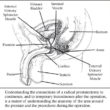A New Treatment Era: Better Outcomes for Prostate Cancer
One Man to Another
A New Treatment Era: Better Outcomes for Prostate Cancer
(It’s Not Your Old Meat and Potatoes)
A revolution is going on in the detection and treatment of prostate cancer,
and I want to make sure that everyone knows about it.

1990s: First Era Of Treatment Success
After about 80 years of poor outcomes from both surgical and radiation treatment for prostate cancer, the first era of success began with the publication in 1982 of an anatomy and method of surgery (prostatectomy) by Dr. Walsh, and the publication in 1991 of a method for PSA screening by Dr. Catalona.
They remain the standard of practice and understanding for many patients and doctors today.
From this standard came the common understanding of screening using a PSA threshold of 4ng/ml to detect cancer and the use of the DRE (digital rectal exam) to find more aggressive tumors.
In the last issue of QUEST , I wrote about a new standard of treatment that is partly described in the NCCN (comprehensive care network of 19 hospital centers) guidelines for 2004 concerning early detection. The new approach to treatment that includes these practice guidelines is what I am calling the new treatment era.
Need for a New Treatment Era
In the first treatment era, surgery or radiation provided successful treatment strategies with curative intent.
That is, doctors hoped for long-term non-recurrence; often it happened, but in many cases it didnt. (The best doctors achieved 80%-85% probability of 10-year non-recurrence after surgery for low-to-medium risk cases. However, in more advanced cases, the outcome was much worse.)
And when the cancer recurred, the medical tools to respond to the new problems were very poor (90% of men are given palliativenon-curativehormonal therapies).
Recurrence, whether early or later, resulted in the same poor choices. (If there was recurrence, 77% of them were during the first 2-3 years; 23% were after 5 years; 4% were after 10 years.)
Recurrence almost always resulted in the use of drugs that greatly lowered quality of life, followed by the use of even harsher drugs after metastasis (spread) of the cancer and then years of suffering and finally death.
After metastasis, men died in about 5 years if their primary therapy was surgery, and about 2 1/2 years if it was radiation.
In the first era, even after long periods of time, recurrence continued to be somewhat likely. Now, men are living to advanced ages.
The conclusion is apparent: surgery and radiation must be so good at producing long term non-recurrence that the use of other methods becomes extremely infrequent.
Treatments must be long lasting.
It is not just death from prostate cancer that patients must obviously avoid, but also, if possible, the need to use any type of drug therapies over a sustained period of time since currently they all have serious deficiencies.
The new treatment era has the potential for resolving the prior problems by providing:
- High levels of long-term non-recurrence
- Therapies to resolve issues of recurrence when they arise
- Durable treatments: Hopefully much longer than 10 years
- Avoidance of long-term use of drug therapies when possible.
Three Great Ideas Form the New Era
(Lower PSA Threshold; IMRT Radiation; PSA Velocity)
Lower PSA Threshold
The new era began in 1995 with Dr. Catalona reporting that he no longer accepted his prior PSA screening standard of 4.0ng/ml.
Reexamination of his data led him to change his own practice to use a PSA screening threshold of 2.5ng/ml.
Dr. Catalona was trying to detect more cancers while minimally increasing the number of times that the PSA test would falsely imply that cancer was present when it was not.
Lower PSA detection resulted in smaller tumor volumes that yield better treatment.
In 2003 Dr. Catalona described tumor volume as the percentage of the volume of the prostate that was occupied by tumor (%Tumor). This %Tumor is helpful because it predicts how PSA values relate to the danger of recurrence (rising PSA) after surgery.
As the %Tumor goes up, the PSA goes up correspondingly. However, it is much more likely that there will be a rising PSA (recurrence) if the %Tumor is large enough.
Therefore, using a lower PSA for screening, results in treating a smaller %Tumor, which, in turn, results in a lower rate of recurrence after surgery. Thats better treatment.
When Dr. Catalona selected the low PSA screening threshold value of 2.5ng/ml, he was not only detecting more cancers, but at that low PSA value the %Tumor was also sufficiently small so that resulting surgical treatment was likely to have much less recurrence.
In addition, supportive radiation therapy would be more effective since these small tumors are more responsive to radiation.
Lowering PSA Threshold to 2.6 affected real patients.
Dr. Catalona (Catalona 1999) showed that when the PSA was 2.6 to 4.0ng/ml at the time of surgery, there was a 15% decrease in recurrence in 7 years, compared to surgery performed when the PSA was 4.1 to 9.9ng/ml (the usual range used during the first era).
The lower the PSA at diagnosis, the later the time of recurrence. Lower PSA at diagnosis meant better results.
Using IMRT Radiation for the Recurrences
Potentially early-recurrence cases can be successfully treated before there is any evidence of a rise in PSA after surgery, with what is called adjuvant radiation therapy.
Later recurrence cases (after a small rise in PSA) can be successfully treated with salvage radiation therapy.
These successes have depended upon using IMRT technology. Very high radiation doses using IMRT technology have become an important area of technical focus; high dose levels are now being cited that were unimaginable a short while ago.
Early use and high dose are the keys to successful radiation treatment for recurrence.
In the new treatment era, the hope is that almost every patient who follows the new rules will be treatable with curative intent by using surgery and then supportive radiation when needed.
PSA Velocity (rate of increase over time)
Recent studies support the use of PSA velocity (and doubling time) to predict outcomes after surgery.
A variety of tests are already in use to guide therapy and monitor outcomes, but current thinking is that pathology data from biopsy or after surgery, and PSA rates of change prior to or after surgery should offer sufficient guidance for reliably using both surgery and supporting radiation with very little overtreatment or undertreatment.
Work is also in progress for improving PSA measurement methods.
Outcomes in the New Era?
We wont really know how well these new approaches work until someone publishes consistent data over a long period of time. By combining results from individual studies we can hopefully estimate an average rate of long-term non-recurrence in the high 90% range. Well have to wait and see what the future truly holds.
New Era of Treatment
Real or Just a hope?
New technologies of the type being discussed here are not nearly as well established as the older approaches. Even more changes are likely as doctors gain experience.
However, the older generation of approaches left too many men with poor options.
Patients should know that the new era of treatment for prostate cancer is upon us, and these medical techniques and strategies are available now.
In the end, however, each man must work out his treatment with his own doctor.
As I see it, for men diagnosed with and treated for prostate cancer, this is a time of the greatest promise of return to life largely as before.
Feedback
Feedback is encouraged. Contact Dr. Catalona at his Website: www.drcatalona.com or send me an e-mail at jules105@aol.com. To see my prior articles, go to the Website and click on Quest Articles. Then scan down and click below my picture.
Click here to read the next article, New-Era Of Treatment vs. PSA-Era, in the One Man to Another series from Jules Reichel.











